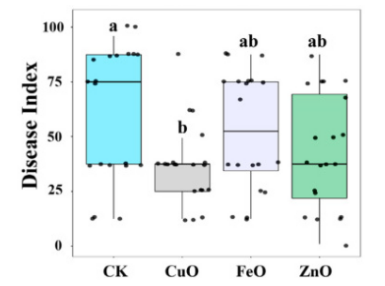A group from Key Laboratory of Biology of Crop Pathogens and Insects of Zhejiang Province, Institute of Biotechnology, Zhejiang University, Hangzhou 310058, China, etc. has reported on strategies for preventing and controlling soil-borne disease tomato bacterial wilt (TBW) with metal oxide Nano-particles (NPs).
https://pubmed.ncbi.nlm.nih.gov/35008839/
Tomato bacterial wilt (TBW) is the most infectious soil-borne bacterial disease in the world. Ralstonia solanacearum is the causal agent of TBW and is recognized as a serious phytopathogen.
The application of CuONPs, FeONPs, and ZnONPs caused 24.3%, 54.6%, and 30.8% increases, respectively, in tomato plant length, compared to the corresponding diseased control. Similarly, TBW infected plants treated with three metal oxide NPs (CuO, FeO, and ZnO) resulted in 32.8%, 78.3%, and 30.6% increases in fresh weight, and 41.0%, 54.1%, and 40.0% increase in dry weight, respectively, compared to the control.
The application of the CuONPs, FeONPs, and ZnONPs treatments decreased the disease incidence significantly to 36.9%, 52.8%, and 42.8%, respectively, compared to the control plants.

From a study of rhizosphere biota, it was found that NPs could affect the abundance of bacteria in the rhizosphere soil to regulate the composition of the bacterial community. Therefore, it would be likely that changes in interaction between bacteria in the rhizosphere microbial community reduced the occurrence of TBW.
